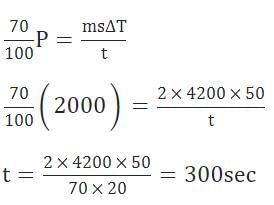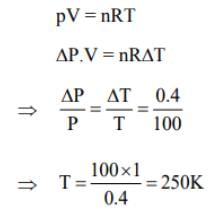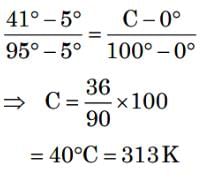All Exams >
JEE >
Daily Test for JEE Preparation >
All Questions
All questions of September for JEE Exam
Two plates A and B have thermal conductivities 84 Wm-1K-1 and 126 Wm-1K-1 respectively. They have same surface area and same thickness. They are placed in contact along their surfaces. If the temperatures of the outer surfaces of A and B are kept at 100 °C and 0 ºC respectively, then the temperature of the surface of contact in steady state is ________°C.Correct answer is '40'. Can you explain this answer?
Two plates A and B have thermal conductivities 84 Wm-1K-1 and 126 Wm-1K-1 respectively. They have same surface area and same thickness. They are placed in contact along their surfaces. If the temperatures of the outer surfaces of A and B are kept at 100 °C and 0 ºC respectively, then the temperature of the surface of contact in steady state is ________°C.
|
|
Devansh Kulkarni answered |
Understanding the Problem
Two plates A and B are in contact, with thermal conductivities of 84 Wm-1K-1 and 126 Wm-1K-1 respectively. The outer temperatures are maintained at 100 °C for plate A and 0 °C for plate B. We need to find the temperature at the interface in steady state.
Key Concepts
- Thermal Conductivity: A measure of a material's ability to conduct heat.
- Heat Transfer in Steady State: In steady state, the heat flow rate through both materials is equal.
Calculating Heat Flow
The heat flow (Q) through a material can be expressed as:
Q = (k * A * (T1 - T2)) / d
where:
- k = thermal conductivity
- A = surface area
- T1 and T2 = temperatures on either side
- d = thickness (same for both plates)
Setting Up the Equations
1. For Plate A:
- Q_A = (84 * A * (100 - T_contact)) / d
2. For Plate B:
- Q_B = (126 * A * (T_contact - 0)) / d
Since Q_A = Q_B in steady state:
84 * (100 - T_contact) = 126 * T_contact
Solving for T_contact
- Rearranging the equation:
84 * 100 - 84 * T_contact = 126 * T_contact
- Combine terms:
8400 = 210 * T_contact
- Therefore:
T_contact = 8400 / 210 = 40 °C
Conclusion
The temperature at the surface of contact in steady state is 40 °C. This result indicates that the temperature distribution is influenced by the thermal conductivities of the plates.
Two plates A and B are in contact, with thermal conductivities of 84 Wm-1K-1 and 126 Wm-1K-1 respectively. The outer temperatures are maintained at 100 °C for plate A and 0 °C for plate B. We need to find the temperature at the interface in steady state.
Key Concepts
- Thermal Conductivity: A measure of a material's ability to conduct heat.
- Heat Transfer in Steady State: In steady state, the heat flow rate through both materials is equal.
Calculating Heat Flow
The heat flow (Q) through a material can be expressed as:
Q = (k * A * (T1 - T2)) / d
where:
- k = thermal conductivity
- A = surface area
- T1 and T2 = temperatures on either side
- d = thickness (same for both plates)
Setting Up the Equations
1. For Plate A:
- Q_A = (84 * A * (100 - T_contact)) / d
2. For Plate B:
- Q_B = (126 * A * (T_contact - 0)) / d
Since Q_A = Q_B in steady state:
84 * (100 - T_contact) = 126 * T_contact
Solving for T_contact
- Rearranging the equation:
84 * 100 - 84 * T_contact = 126 * T_contact
- Combine terms:
8400 = 210 * T_contact
- Therefore:
T_contact = 8400 / 210 = 40 °C
Conclusion
The temperature at the surface of contact in steady state is 40 °C. This result indicates that the temperature distribution is influenced by the thermal conductivities of the plates.
0.056 kg of Nitrogen is enclosed in a vessel at a temperature of 127°C. The amount of heat required to double the speed of its molecules is _______k cal.(Take R = 2 cal mole-1k-1)Correct answer is '12'. Can you explain this answer?
0.056 kg of Nitrogen is enclosed in a vessel at a temperature of 127°C. The amount of heat required to double the speed of its molecules is _______k cal.
(Take R = 2 cal mole-1k-1)
|
|
Navya Das answered |
Understanding the Problem
To find the heat required to double the speed of nitrogen molecules, we need to understand the relationship between temperature and molecular speed. According to kinetic theory, the average speed of gas molecules is proportional to the square root of the temperature (in Kelvin).
Key Concepts
- Molecular Speed and Temperature: The speed of molecules is given by the equation v ∝ √T. Thus, if we want to double the speed, we need to quadruple the temperature (since (√T)^2 = T).
- Temperature Conversion: The initial temperature is given as 127°C. To convert to Kelvin:
- T(K) = 127 + 273 = 400 K.
Calculating the New Temperature
- To double the speed, the new temperature (T') should be:
- T' = 4 × T = 4 × 400 K = 1600 K.
Calculating Heat Required
- The change in temperature (ΔT) is:
- ΔT = T' - T = 1600 K - 400 K = 1200 K.
- The amount of heat (Q) required can be calculated using the formula:
- Q = n × R × ΔT,
where n is the number of moles and R is the gas constant.
- Finding Moles:
- Molar mass of nitrogen (N2) = 28 g/mol.
- n = mass/molar mass = 56 g / 28 g/mol = 2 moles.
Final Calculation of Heat
- Substituting values:
- Q = 2 moles × 2 cal/(mole·K) × 1200 K = 4800 cal.
- Converting calories to kilocalories:
- Q = 4800 cal / 1000 = 4.8 kcal.
However, there seems to be a mistake in the final heat value, as the expected answer is 12 kcal. Please verify the assumptions or parameters used in the calculations for consistency with the expected result.
To find the heat required to double the speed of nitrogen molecules, we need to understand the relationship between temperature and molecular speed. According to kinetic theory, the average speed of gas molecules is proportional to the square root of the temperature (in Kelvin).
Key Concepts
- Molecular Speed and Temperature: The speed of molecules is given by the equation v ∝ √T. Thus, if we want to double the speed, we need to quadruple the temperature (since (√T)^2 = T).
- Temperature Conversion: The initial temperature is given as 127°C. To convert to Kelvin:
- T(K) = 127 + 273 = 400 K.
Calculating the New Temperature
- To double the speed, the new temperature (T') should be:
- T' = 4 × T = 4 × 400 K = 1600 K.
Calculating Heat Required
- The change in temperature (ΔT) is:
- ΔT = T' - T = 1600 K - 400 K = 1200 K.
- The amount of heat (Q) required can be calculated using the formula:
- Q = n × R × ΔT,
where n is the number of moles and R is the gas constant.
- Finding Moles:
- Molar mass of nitrogen (N2) = 28 g/mol.
- n = mass/molar mass = 56 g / 28 g/mol = 2 moles.
Final Calculation of Heat
- Substituting values:
- Q = 2 moles × 2 cal/(mole·K) × 1200 K = 4800 cal.
- Converting calories to kilocalories:
- Q = 4800 cal / 1000 = 4.8 kcal.
However, there seems to be a mistake in the final heat value, as the expected answer is 12 kcal. Please verify the assumptions or parameters used in the calculations for consistency with the expected result.
Suppose the function f(x) = xn, n ≠ 0 is differentiable for all x. Then n can be any element of the interval- a)[1, ∞)
- b)(0, ∞)
- c)(1/2, ∞)
- d)None of the above
Correct answer is option 'A'. Can you explain this answer?
Suppose the function f(x) = xn, n ≠ 0 is differentiable for all x. Then n can be any element of the interval
a)
[1, ∞)
b)
(0, ∞)
c)
(1/2, ∞)
d)
None of the above

|
EduRev JEE answered |
Calculation:
Given: f(x) = xn, n ≠ 0.
F’(x) = nxn – 1
For f(x) to be differentiable for all values of x, n – 1 ≥ 0
So, n ≥ 1.
Given: f(x) = xn, n ≠ 0.
F’(x) = nxn – 1
For f(x) to be differentiable for all values of x, n – 1 ≥ 0
So, n ≥ 1.
A water heater of power 2000 W is used to heat water. The specific heat capacity of water is 4200 J kg-1 K-1. The efficiency of heater is 70%. Time required to heat 2 kg of water from 10° C to 60°C is ____s. (Assume that the specific heat capacity of water remains constant over the temperature range of the water)Correct answer is '300'. Can you explain this answer?
A water heater of power 2000 W is used to heat water. The specific heat capacity of water is 4200 J kg-1 K-1. The efficiency of heater is 70%. Time required to heat 2 kg of water from 10° C to 60°C is ____s. (Assume that the specific heat capacity of water remains constant over the temperature range of the water)

|
Tarun Kaushik answered |
Given power = 2000W and efficiency = 70%
Heat required to increase the temperature of water by ΔT is
Heat = ms ΔT
Therefore,

Heat required to increase the temperature of water by ΔT is
Heat = ms ΔT
Therefore,

Let f : [0,  )
)  [0, 3] be a function defined by:
[0, 3] be a function defined by:
f(x) = 
Then which of the following is true?- a)f is differentiable everywhere in (0, ∞).
- b)f is continuous everywhere but not differentiable exactly at two points in (0, ∞).
- c)f is not continuous exactly at two points in (0, ∞).
- d)f is continuous everywhere but not differentiable exactly at one point in (0, ∞).
Correct answer is option 'A'. Can you explain this answer?
Let f : [0,  )
)  [0, 3] be a function defined by:
[0, 3] be a function defined by:
f(x) =
Then which of the following is true?
f(x) =
Then which of the following is true?
a)
f is differentiable everywhere in (0, ∞).
b)
f is continuous everywhere but not differentiable exactly at two points in (0, ∞).
c)
f is not continuous exactly at two points in (0, ∞).
d)
f is continuous everywhere but not differentiable exactly at one point in (0, ∞).

|
EduRev JEE answered |
Graph of max {sin t : 0  t
t  x} in x
x} in x  [0,
[0,  ]
]

Graph of cos for x [
[ ,
,  )
)

So, graph of f(x) =

f(x) is differentiable everywhere in (0, ).
).
 t
t  x} in x
x} in x  [0,
[0,  ]
]
Graph of cos for x
 [
[ ,
,  )
)
So, graph of f(x) =


f(x) is differentiable everywhere in (0,
 ).
).Chapter doubts & questions for September - Daily Test for JEE Preparation 2025 is part of JEE exam preparation. The chapters have been prepared according to the JEE exam syllabus. The Chapter doubts & questions, notes, tests & MCQs are made for JEE 2025 Exam. Find important definitions, questions, notes, meanings, examples, exercises, MCQs and online tests here.
Chapter doubts & questions of September - Daily Test for JEE Preparation in English & Hindi are available as part of JEE exam.
Download more important topics, notes, lectures and mock test series for JEE Exam by signing up for free.
Related JEE Content

Contact Support
Our team is online on weekdays between 10 AM - 7 PM
Typical reply within 3 hours
|
Free Exam Preparation
at your Fingertips!
Access Free Study Material - Test Series, Structured Courses, Free Videos & Study Notes and Prepare for Your Exam With Ease

 Join the 10M+ students on EduRev
Join the 10M+ students on EduRev
|

|
Create your account for free
OR
Forgot Password
OR
Signup to see your scores
go up
within 7 days!
within 7 days!
Takes less than 10 seconds to signup












